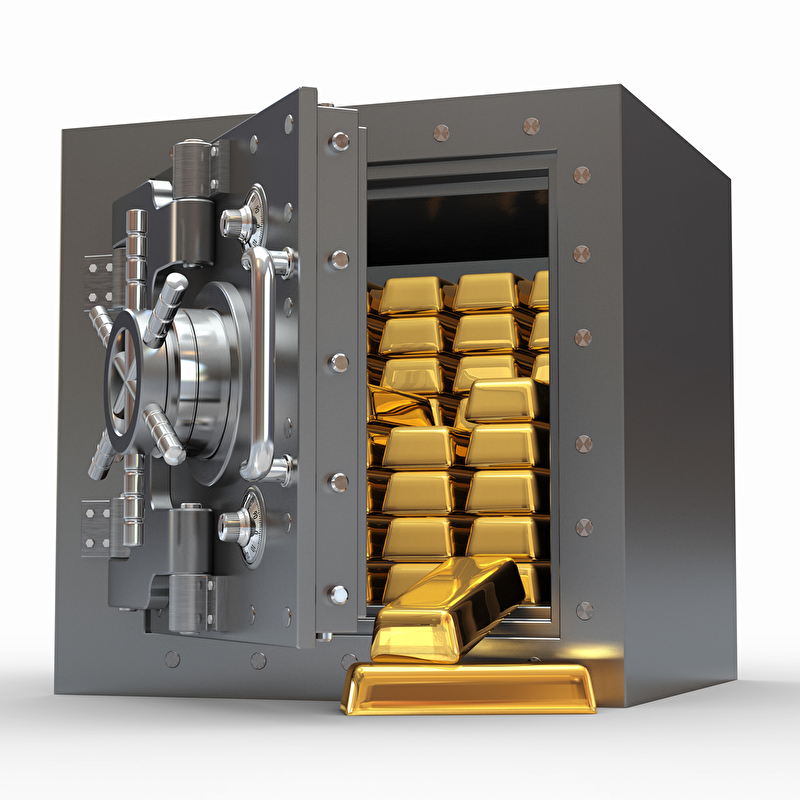Gold bars – facts and tips on value, security and alternatives
Gold facts & figures Arnulf Hinkel, Finanzjournalist – 29.11.2024

Where can I buy reputable gold bars, what is the best size and how do I store the gold safely? What tax issues need to be considered – and what are the alternatives?
Investing in gold has been shown to be a sensible way of diversifying stock/bond-based portfolios. When it comes to purchasing the precious metal, gold bars are usually the first choice. So, what is the best way to buy gold, the ideal size, and how can it be stored safely? Are there tax issues to be considered? And are gold coins a good alternative?
A brief introduction to the world of gold bars
Archaeological finds show that gold bars have been in the hands of humans for at least 6,500 years. Initially, the precious metal was used primarily for religious purposes and to display wealth and power, but the widespread use of small gold tokens as a means of exchange and payment, as well as a store of value, quickly followed. To make these gold pieces more easily comparable, somewhat standardised casting moulds were soon used to produce gold bars. These bars were an early means of payment and eventually led to the introduction of gold coins with a declared value. It took a long time before coins of uniform value and appearance came into circulation. In 560 BC, the legendary King Croesus of Lydia introduced the first standardised gold coins with a mint stamp. When gold coins were officially introduced as money, the importance of gold bars declined, but they remain in demand around the world by investors as stores of value.
What defines a gold bar?

Gold bars, or ingots, must have a purity of 995/1,000, and bars with an even higher purity of 999.9/1,000 are also available. There are two different types of production: Gold bars weighing 250 grams or more are cast, and referred to as minted bars, usually much flatter than cast bars. Both types of bars are rectangular in shape; cast bars tend to look rather rough, while minted bars are somewhat reminiscent of gold coins.
All internationally recognised gold bars generally accepted by gold dealers and banks have certain information in common – usually stamped or cast directly onto the bars. Some information may also be provided on the packaging if the bar is shrink-wrapped in a display package. In addition to the manufacturer’s name, the precious metal must be precisely labelled – in this case, fine gold. It must also state the gold content in thousandths, as already mentioned, weight specification in grams, kilograms or troy ounces (or tola and tael in the Middle East and Asia) and serial number. This only applies to larger bars, as only small and medium-sized bars are sold in blister packs. In contrast to gold coins, gold bars never bear a nominal value; theirs is the respective current spot price for gold, as determined twice daily by the London Bullion Market Association (LBMA).
To ensure a smooth resale, it is advisable to only acquire bars from manufacturers holding a ‘Good Delivery’ certification from the LBMA. The most important seal of quality for gold bars worldwide, it is only awarded to manufacturers that meet precisely defined quality standards.
Gold bars vs. gold coins – what’s the difference?

Gold bars and coins do not only differ considerably in appearance: Gold coins often have a lower gold content than bars. However, there are also – mostly renowned – coins whose purity of 999/1,000 is equal to that of gold bars, such as Philharmonic coins, Maple Leaf or Krugerrand. For smaller investments, it is generally a matter of taste whether to choose gold bars or coins. However, the premium is higher compared to the spot price for gold – reflecting the more complex production of gold coins. Investors should also use caution regarding limited-edition collector’s coins. If unpopular, their value can easily decrease to the pure material gold value – which can be lower than the purchase price.
To acquire larger amounts of physical gold, gold bars are clearly preferable in terms of price. The larger the bar, the lower the price premium per gram or ounce. The difference in price between gold bars and coins is particularly significant in weights of 100 grams or more. Another argument in favour of gold bars is the higher counterfeit risk with coins, especially with rare specimens or collector’s editions.
Can you check the authenticity of gold bars?
For private investors, the easiest way to test the authenticity of gold bars is to purchase through a trustworthy seller – a reputable bank, well-known gold dealer or manufacturer. You can even buy gold online without having to worry about inferior quality or even forgeries. However, you should be wary of online bargains or seemingly great deals you might be offered while travelling. Simple authenticity tests may be helpful. Entirely reliable methods such as the acid test, an ultrasound and X-ray fluorescence analysis or the analysis of electrical conductivity are exclusive to professionals. There are, however, a few ‘home remedies’ available to laypeople. In addition to a simple abrasion test with a piece of ceramic, which should leave a yellow trace after the test, a magnet test can also indicate authenticity. Pure gold is not attracted by a magnet – a gold bar that proves to be magnetic probably consists largely of another metal. The water displacement test, developed by Archimedes in the 3rd century BC, also provides evidence whether a gold bar is genuine. While the test is not entirely without difficulty, it can be conducted by laypersons. Learn more in our “Goldwissen” article “Twelve ways to check the authenticity of gold”.
After the purchase: how and where to safely store gold bars

Storing investment gold at home may seem like a good option – being able to keep an eye on and access the gold bars at any time. However, with the increasing number of burglaries – in 2023, there were almost 78,000 in Germany alone – a good hiding place might not suffice to keep the gold safe. Professional burglars usually find their way into even the most seemingly ingenious stash. A home safe with a sufficiently high certified security level (costing from €2,000 for an investment value of up to €400,000) and dead weight of less than 100 kg, must be installed securely to prevent burglars from seizin the entire safe. A special insurance or coverage general household insurance is also important.
A safe deposit box at the house bank, gold dealer or an independent provider is significantly cheaper. Rental costs vary – as does the liability sum in the event of burglary or robbery. According to a study by Stiftung Warentest in July 2024, the annual costs for a bank safe deposit box vary between €120 and €300, with the lump-sum sums insured often ranging between €10,000 and €20,000. Additional insurance is therefore often required. For large quantities of gold bars, so-called high-security warehouses and duty-free warehouses are also available for long-term storage. The advantage: professional security concepts and precautions. Due to limited opening hours, these options do not offer access to the stored gold at all times.
Taxes applicable to the purchase and sale of gold bars
First the good news: no VAT or sales tax is due on the purchase of investment gold. This includes all gold bars and gold coins with a purity of at least 90 per cent, considered investment gold according to EU Directive 98/80/EC1. The even better news: upon sale of the gold bars, the German 25 per cent withholding tax on capital gains, otherwise due on capital income from investments or securities transactions, does not apply, provided the required holding period of at least twelve months is adhered to. Sale of gold bars before expiration of this period automatically triggers the requirement to pay withholding tax on capital gains. The tax-exempt threshold is €600. Incidentally, the regulation applies also applies to any capital gains from scrap gold, such as jewellery. And up to a value of €1,999.99, gold can be bought and sold anonymously.
Grams, troy ounces or kilos?
Gold bars are available in various weights. The most popular size among private investors is the 100-gram bar. In the metric system, 1g, 2g, 2.5g, 5g, 10g, 20g, 50g, 250g, 500g and 1-kilo bars are also available. In addition, one-troy-ounce gold bars are popular in the Anglo-American system of measurement, corresponding to 31.1g. So-called combination bars often consist of 5, 10, 15 or 20 one-gram gold bars which can be divided at their predetermined breaking points as needed. The smallest possible denomination is advantageous if you want to remain flexible or if the bar is to serve as a gift. However, this is also the most expensive way to buy gold bars. In comparing the price of a one-gram bar with the spot price for gold, you will notice an 18 per cent mark-up. The larger the bar, the smaller the mark-up: a 100-gram bar, for example, is only 1.5 per cent more expensive, and a one-kilo bar is only 0.9 per cent more expensive. Furthermore, the trading margin – the difference between the purchase and selling price – is particularly high for very small bars: a whopping 20 per cent for one-gram bars versus 3 per cent for 100-gram bars. Larger gold bars are therefore more suitable for a long-term investment.
How does the price of gold develop and what is it influenced by?

Since the introduction of euro notes and coins in early 2002, the price per gram of gold has risen more than sixfold, from around €10 to a good €60 at the end of 2023. This year, the gold price was up almost 22 per cent to €7 by mid-September. Int has been 23 years since the introduction of the single currency, and the gold price has dropped in only four of them, and mostly only very slightly, apart from one 31 per cent drop. Another reason why gold bars are better suited for long-term investments.
Since gold has a dual economic function – as a scarce raw material for jewellery, medical purposes, high-tech, chemical and automotive industries as well as an investment – its performance depends on significantly more factors than, for example, the price development of a stock. It is therefore more difficult to predict. In terms of influencing factors, economic developments are just as important the geopolitical situation, the US dollar exchange rate, inflation, foreign currency reserve strategies and central banks’ key interest rate policies,o technical innovation and, last but not least, the production costs of the precious metal, which are continuously rising due to its scarcity. To learn more, please read our article “Gold price development: ten major influencing factors”.
What are the alternatives to buying gold bars?
Our gold knowledge article ‘Investing in gold: how to find the right product for every type of investor’ offers a comprehensive overview of the various gold investment options. Generally, the main reason for indirect gold investments in the form of securities is the fact that the purchase and secure storage of gold bars and coins entails costs which can be effectively avoided with suitable financial instruments. When choosing alternatives to investing in physical gold, it is important to ensure that the risk of loss is no higher than with gold bullion, i.e. the risk of default of an issuer of gold securities must not be a factor to be taken into account. The obvious option would be to invest in gold ETFs, which are considered special funds, effectively eliminating the issuer risk. However, since the UCITS guidelines do not allow ETFs with only one component to be offered within the EU due to the legal framework, so-called ETCs (exchange-traded commodities) have taken on the role of ETFs in Europe. ETCs are debt securities which generally involve an issuer risk. Many gold ETCs such as Xetra-Gold are therefore physically backed by gold bars. For each Xetra-Gold unit traded, the corresponding amount of physical gold is purchased and securely stored. In addition, each Xetra-Gold unit securitises the right for its owner to have the invested amount of physical gold delivered. It should be noted that exercising this right incurs costs which partially offset the advantage of higher cost efficiency.
Another aspect that should play a role in the decision ‘Xetra-Gold or gold bullion?’ is, of course, trust in the stability of the European financial system or a lack thereof: in the event of a collapse, it would actually be safer to store physical gold at home than at the bank or in the form of securities. Those who have no such qualms may fully participate in the performance of gold with Xetra-Gold and other physically backed ETCs, and without actually having to pay for the storage of gold bars or coins.
Xetra-Gold Hotline

Do you have questions? We have the answers. Contact us here: 9 a.m.–6 p.m. CET
xetra-gold(at)deutsche-boerse.com
For press inquiries: media-relations(at)deutsche-boerse.com




